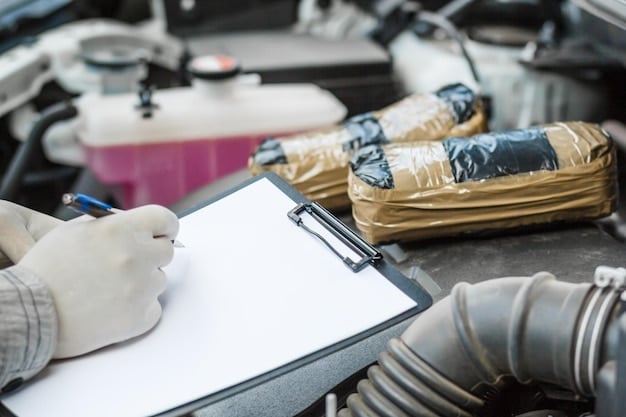Car Prep for Extreme Weather: Seasonal Checklist

Preparing your car for extreme weather involves a proactive, seasonal approach, ensuring critical systems are inspected and maintained to enhance safety and reliability during diverse environmental challenges, from harsh winters to scorching summers.
As seasons shift, so do driving conditions. From scorching summer tarmac to icy winter roads, your vehicle endures a relentless barrage of environmental stresses. Knowing How to Prepare Your Car for Extreme Weather Conditions: A Seasonal Checklist isn’t just about comfort; it’s a critical aspect of vehicle longevity, safety, and operational reliability, ensuring you’re ready for whatever Mother Nature throws your way.
Understanding the Impact of Extreme Weather on Vehicles
Extreme weather conditions, whether blistering heat waves, prolonged deep freezes, torrential downpours, or heavy snowfalls, exert immense stress on every component of a vehicle. This stress can accelerate wear and tear, compromise safety systems, and even lead to unexpected breakdowns. Recognizing these impacts is the first step toward effective seasonal preparation.
Each season presents its unique challenges. Summer heat can degrade fluids, test cooling systems, and expand tire pressure beyond safe limits. Winter’s cold, conversely, can congeal oils, drain batteries, and stiffen rubber components, leading to reduced efficiency and potential failure. Rain and humidity introduce risks of hydroplaning and exacerbate corrosion, while strong winds can affect vehicle stability.
Heat’s Silent Assault: Summer’s Toll on Your Car
High temperatures are often underestimated as a threat to vehicle health. The internal combustion engine generates immense heat, and when ambient temperatures soar, the cooling system works overtime. Overheating is a common issue, leading to damage in the engine, radiator, and hoses. Beyond the engine, batteries suffer too; while cold reduces their output, heat actually shortens their lifespan by accelerating internal chemical reactions.
- Fluid Degradation: Engine oil, transmission fluid, brake fluid, and coolant can degrade faster under intense heat, losing their lubricating and protective properties.
- Tire Pressure Fluctuation: Heat causes air inside tires to expand, increasing pressure and the risk of a blowout, especially if tires are already worn or overinflated.
- A/C System Strain: The air conditioning system works harder, placing more demand on the engine and increasing fuel consumption, while potential leaks or low refrigerant levels become more apparent.
Understanding these specific thermal stresses helps prioritize maintenance during warmer months. Regular checks of fluid levels and conditions, along with tire pressure adjustments, become paramount.
Winter’s Icy Grip: The Cold Hard Truth
Winter brings its own set of formidable challenges. Freezing temperatures can turn essential fluids thick and sluggish, reduce battery cranking power, and make parts brittle. Road salt, used for de-icing, is highly corrosive, attacking the undercarriage, brake lines, and electrical connections. Reduced visibility due to snow and ice also demands optimal lighting and windshield wiper performance.
- Battery Performance: Cold greatly reduces a battery’s capacity, making it harder to start the engine, especially if the battery is already old or weak.
- Fluid Viscosity: Engine oil thickens, making it harder for the engine to circulate at startup, leading to increased wear. Coolant issues can also arise if the anti-freeze mixture is incorrect.
- Tire Traction: Standard tires lose significant grip on icy or snowy surfaces, making winter or all-season tires a crucial consideration for safety.
The cumulative effects of extreme conditions can lead to accelerated wear, costly repairs, and, most importantly, compromised safety. Proactive preparation mitigates these risks, ensuring the vehicle remains a reliable mode of transport regardless of the forecast.

The Autumn Checklist: Preparing for Colder Months
As the vibrant colors of autumn emerge, it’s a signal to begin the crucial transition into winter-readiness for your vehicle. This period offers a unique window to address potential vulnerabilities before the harsh cold sets in. A meticulous autumn checklist focuses on safeguarding against freezing temperatures, ensuring optimal visibility, and preserving overall vehicle integrity.
The preventive measures taken during this season are perhaps the most vital, as they directly impact your safety and comfort during the peak of winter. Ignoring these steps can lead to anything from inconvenient breakdowns to hazardous driving conditions. It’s about being one step ahead of the weather.
Battery Health and Charging System
The cold significantly diminishes battery power, with a fully charged battery at 0°F (–18°C) having only half its cranking power compared to 80°F (26°C). Simultaneously, the engine’s oil thickens, requiring more power to turn over. This double whammy makes battery inspection paramount in autumn. Have your battery and charging system tested by a professional. Look for corrosion on the terminals and ensure connections are tight. A battery older than three years should be viewed with suspicion and possibly replaced proactively.
Tire Inspection and Winter Tires
Tires are your vehicle’s only contact with the road, and their performance is critical in adverse conditions. As temperatures drop below 45°F (7°C), the rubber compounds in all-season and summer tires begin to stiffen, drastically reducing grip. Evaluate your tire tread depth; a minimum of 4/32 inch (about 3.2 mm) is recommended for winter driving. Consider installing dedicated winter tires if you live in an area with significant snow and ice. These tires feature specialized rubber compounds that remain flexible in the cold and unique tread patterns for enhanced traction. Proper inflation is also key, as tire pressure drops with ambient temperature.
Brakes and Fluid Levels Check
Effective braking is non-negotiable for winter driving. Have your brakes inspected for wear on pads, rotors, and calipers. Ensure the brake fluid level is correct and its condition is good. Brake fluid absorbs moisture over time, which can freeze and cause issues in cold temperatures. Beyond brakes, check all other fluid levels: engine oil, transmission fluid, power steering fluid, and, most critically, coolant/antifreeze. Ensure your coolant mixture provides adequate freezing protection, typically a 50/50 mix of antifreeze and distilled water, protecting down to about -34°F (-37°C). Don’t forget your windshield washer fluid; replace it with a winter-specific formula that resists freezing.
Wipers, Lights, and Visibility
Shortened days and increased precipitation demand optimal visibility. Inspect your windshield wipers for cracks or tears in the rubber and replace them if they leave streaks or miss spots. Consider winter-specific blades, which are designed to resist ice buildup. All exterior lights – headlights, taillights, brake lights, and turn signals – must be clean and fully operational. Ensure your defrosters work effectively for both front and rear windows.
- Wiper Blade Replacement: Ensure new, streak-free blades are installed for clear vision in rain, snow, and slush.
- Headlight and Taillight Functionality: Verify all bulbs are working and lenses are clean and free of haze for maximum visibility.
- Defroster Efficiency: Test front and rear defrosters to ensure they clear condensation and ice quickly.
Autumn maintenance is about foreseeing potential problems and addressing them proactively. It’s an investment in safety and peace of mind during the challenging winter months.
Winter Driving Essentials: Navigating the Cold Safely
Winter driving demands a heightened level of awareness and preparation. Beyond the seasonal checks done in autumn, there are specific items and practices that become indispensable during the coldest months. Navigating icy roads, enduring snowstorms, and facing biting winds require more than just a well-maintained car; they require a well-equipped driver and vehicle.
The emphasis shifts from preventative maintenance to immediate utility and emergency preparedness. Having the right tools and supplies in your vehicle can make the difference between a minor inconvenience and a dangerous situation, especially if you get stranded.
Emergency Car Kit for Winter
Every vehicle should carry an emergency kit year-round, but it becomes particularly vital in winter. This kit should include items to keep you warm, signal for help, and perform minor roadside repairs. A well-stocked kit ensures you are equipped to handle unexpected delays or breakdowns in freezing conditions.
- Warmth and Comfort: Blankets or sleeping bags, extra warm clothing (hats, gloves, scarves), and hand warmers.
- Signaling and Visibility: Flares or reflective triangles, a bright flashlight with extra batteries, and a brightly colored cloth.
- Food and Hydration: Non-perishable food items (energy bars, nuts) and bottled water (keep it insulated to prevent freezing).
- Battery and Charging: Jumper cables and a portable jump starter.
- Traction and Towing: Sand, cat litter, or traction mats for getting unstuck, and a small shovel.
- First Aid: A comprehensive first-aid kit, along with any necessary personal medications.
Winter Driving Techniques and Tips
Safe winter driving is a skill, not just a matter of having the right equipment. The key principles revolve around reducing speed, increasing following distance, and making smooth, gentle inputs. Avoid sudden braking, acceleration, or steering, as these can easily lead to a loss of traction. If your vehicle has anti-lock brakes (ABS), remember to press the pedal firmly and steadily; don’t pump them. For vehicles with traction control or electronic stability control, understand how these systems assist you and avoid overriding them unless specifically instructed for expert maneuvers in deep snow.
Be aware of “black ice” – a thin, transparent layer of ice that’s incredibly difficult to see. It often forms on bridges, overpasses, and shaded areas. If you hit black ice, remain calm, ease off the accelerator, and steer gently in the direction you want the front of the car to go. Do not slam on the brakes. Regularly check weather forecasts and road conditions before driving, and consider delaying travel if conditions are particularly severe.
Winter driving is about patience and caution. Giving yourself extra time, staying alert, and knowing your vehicle’s capabilities are crucial for a safe journey through the colder months.
The Spring Refresh: Recovering from Winter’s Bite
As winter’s chill recedes and the days grow longer, spring offers a perfect opportunity to reverse the effects of cold weather and road salt on your vehicle. This is a critical period for inspection and maintenance, as conditions transition from freezing to warmer, exposing potential issues that winter may have masked. A thorough spring refresh prepares your car for the warmer months ahead and addresses any lingering winter damage.
The focus during spring shifts to cleaning, checking for wear caused by salt and extreme cold, and ensuring all systems are optimal for increasing temperatures and varied driving conditions typical of spring. It’s a chance to restore your vehicle’s integrity and appearance.
Undercarriage Wash and Rust Inspection
Road salt and de-icing chemicals are highly corrosive and cling to your vehicle’s undercarriage and wheel wells throughout winter. These chemicals can accelerate rust on the frame, suspension components, brake lines, and exhaust system. As soon as temperatures allow, give your car a thorough wash, paying special attention to the undercarriage. Many car washes offer an undercarriage spray. Conduct a visual inspection for any signs of rust or damage that may have occurred over the winter. Addressing rust early can prevent more significant, costly issues down the line.
Tire Rotation and Alignment Check
Spring is an ideal time to rotate your tires, ensuring even wear and extending their lifespan. If you used winter tires, now is the time to remove them and reinstall your all-season or summer tires. This is also a good opportunity to have your wheel alignment checked. Potholes and rough winter roads can throw off your alignment, leading to uneven tire wear, reduced fuel efficiency, and compromised handling. Proper alignment ensures your tires meet the road at the correct angle, promoting smooth driving and preventing premature tire replacement.
Wiper Blades and Fluid Top-Offs
Winter can be particularly harsh on wiper blades, with ice and snow often causing nicks and tears. Even if you replaced them in autumn, inspect them again in spring for any signs of wear. Replace them if they leave streaks or don’t clear the windshield efficiently. Top off all fluids, including engine oil, transmission fluid, power steering fluid, and brake fluid. Pay close attention to your windshield washer fluid, switching back to a standard or all-season formula if you had a winter-specific one. Check hoses and belts for cracks or signs of wear that may have developed due to prolonged exposure to cold.
Air Conditioning System Check
After months of dormancy, your car’s air conditioning system will soon be called into action. Before the summer heat hits, have your A/C system checked. This includes inspecting the refrigerant levels, ensuring the compressor is functioning correctly, and checking for any leaks. A well-functioning A/C system not only keeps you comfortable but also helps defog windows on humid days. Addressing any A/C issues now will save you from sweating it out when summer arrives.
- A/C Performance Test: Turn on your A/C and ensure it blows cold air effectively and consistently.
- Refrigerant Levels: Check if refrigerant levels are adequate; low levels can indicate a leak.
- Filter Inspection: Consider replacing the cabin air filter if it’s dirty, which can affect A/C performance and air quality.
The spring refresh is a vital step in maintaining your car’s health and ensuring it transitions smoothly from the harshness of winter to the demands of summer driving. It’s about proactive care that prevents breakdowns and maximizes your vehicle’s lifespan.

Summer Readiness: Battling the Heat and Humidity
Summer brings with it unique challenges for your vehicle, primarily centered around heat, humidity, and increased road trips. While winter focuses on battling the cold and ice, summer readiness shifts attention to preventing overheating, ensuring optimal tire performance, and maintaining comfort in sweltering conditions. Proactive measures now can save you from inconvenient breakdowns on busy highways.
The intense heat puts immense strain on major systems, particularly the cooling system, battery, and tires. Humidity can also accelerate corrosion and affect electrical components. A thorough summer prep ensures your vehicle can handle the demands of warmer temperatures and extended travel.
Cooling System Overhaul
The cooling system is arguably your car’s most important defense against summer heat. It prevents the engine from overheating, which can lead to severe engine damage. Check your coolant levels, and ensure the mixture is correct (typically a 50/50 mix of coolant and distilled water). Inspect all hoses for cracks, bulges, or leaks, and ensure clamps are secure. The radiator cap should be tight and in good condition. Consider flushing the cooling system and refilling with fresh coolant every few years, as recommended by your manufacturer. This removes contaminants and ensures maximum heat transfer efficiency. Also, check the radiator and condenser fins for debris that can block airflow.
Oil and Fluid Maintenance
Engine oil, transmission fluid, and brake fluid all work harder in high temperatures. Check their levels and conditions. Engine oil should be changed according to your manufacturer’s schedule, or more frequently if you drive in extreme conditions or do a lot of stop-and-go driving. Ensure you are using the correct viscosity of oil recommended for your vehicle; some manufacturers specify different viscosities for very hot climates. Inspect brake fluid and power steering fluid levels and top them off if necessary. Remember, these fluids are vital for your car’s performance and safety.
Tire Pressure and Tread Depth
Heat causes air to expand, so your tire pressure will naturally increase. Check your tire pressure when the tires are cold (before driving) and inflate them to the manufacturer’s recommended PSI, usually found on a sticker inside the driver’s side door jamb. Never rely solely on the maximum pressure listed on the tire sidewall. Also, inspect your tire tread depth for adequate grip. Worn tires are more prone to hydroplaning during heavy summer downpours and are more susceptible to punctures or blowouts, especially on hot pavement. Ensure your spare tire is also properly inflated and in good condition.
Battery Check for Heat Stress
While cold can make a battery struggle to start, heat is actually what shortens its lifespan. High temperatures evaporate battery fluid and accelerate internal corrosion. Have your battery and charging system tested by a professional. Clean any corrosion from the battery terminals and ensure connections are secure. If your battery is older than three years, consider replacing it proactively to avoid being stranded in the heat.
- Battery Load Test: A professional load test indicates the battery’s ability to hold a charge under stress.
- Terminal Cleaning: Remove any white or greenish corrosion from terminals to ensure good electrical contact.
- Fluid Level (if applicable): For older, non-sealed batteries, check and top off distilled water levels if low.
Preparing your car for summer means ensuring it can disperse heat effectively, maintain optimal fluid performance, and provide reliable service during long trips and daily commutes in warm conditions. It’s about comfort, efficiency, and most importantly, safety.
Special Considerations for Regional Extreme Weather
While general seasonal preparedness is essential, driving in specific regions means confronting unique extreme weather patterns. From the hurricane-prone coasts to the dust-blown deserts and fire-prone forests, understanding and preparing for these localized threats is paramount. Tailoring your vehicle’s preparation to these specific environmental challenges can significantly enhance safety and resilience.
Generic checklists might cover common scenarios, but regional extremes demand specialized attention and sometimes, different equipment. This section dives into the unique atmospheric and road conditions found in distinct geographical areas.
Coastal and Humid Regions: Salt, Humidity, and Flooding
Coastal areas are plagued by saltwater corrosion and high humidity, while also being susceptible to sudden, intense rainfall and storm surges leading to flooding. Vehicles in these regions require extra vigilance against rust. Regular, thorough undercarriage washes are crucial to remove salt spray. Applying anti-corrosion sprays or coatings can add an extra layer of protection. Electrical systems are also vulnerable to moisture; ensure all connections are sealed and inspect for any signs of corrosion regularly. During hurricane season or periods of heavy rain, avoid driving through flooded streets as even shallow water can cause irreparable damage to the engine (hydro-locking) or electrical systems. Water can damage brakes, cause wheel bearings to rust, and compromise vehicle electronics. Consider raising your vehicle’s ride height if possible and installing snorkel kits for off-road vehicles in areas prone to deep water, though this is for very specific scenarios and not general advice for all cars.
Desert Environments: Sand, Extreme Heat, and Dust
Driving in desert environments presents a different set of challenges: scorching temperatures, abrasive sand, and pervasive dust. Engine cooling systems must be in peak condition to prevent overheating in 100°F+ (38°C+) heat. Regular checks of coolant levels and radiator functionality are vital. Air filters need more frequent replacement due to airborne dust and sand, which can clog them quickly and reduce engine performance. Consider heavy-duty air filters if you frequent dusty unpaved roads. The intense sun can degrade tires and rubber components rapidly; use UV protectants for tires and exterior trims. Keep extra water onboard for both yourself and potential radiator top-offs. Inspect windshields for pitting from wind-blown sand, which can impair visibility over time.
Mountainous and Snowy Terrain: Steep Grades, Ice, and Chains
Mountainous regions with heavy snowfall combine the challenges of extreme cold with difficult topography. Beyond the standard winter prep, vehicles in these areas benefit from specific considerations. All-wheel drive (AWD) or four-wheel drive (4WD) systems are highly advantageous. Winter tires are almost a necessity, and carrying tire chains or cables might be legally required during certain conditions or on specific passes. Your brakes will experience more wear due to continuous use on descents; ensure they are in excellent condition. Proper brake fluid levels and healthy brake pads are non-negotiable. Engine braking (using lower gears to slow down) is a valuable technique to save brakes on long descents. Check your vehicle’s ground clearance to prevent getting stuck in deep snow.
- Vehicle Ground Clearance: Higher ground clearance can be beneficial to avoid getting stuck in deep snow.
- Engine Braking Usage: Utilize lower gears on descents to preserve brakes and maintain control.
- Fuel Level: Keep your fuel tank at least half full to prevent fuel lines from freezing and to allow for extended idling if stranded.
Understanding these regional nuances is key to truly preparing your vehicle for the specific extreme weather conditions it will encounter. It ensures a more tailored and effective approach to vehicle maintenance and safety.
Proactive Maintenance Schedule and Record Keeping
Beyond seasonal checklists and regional considerations, the foundation of a well-prepared vehicle lies in adherence to a consistent, proactive maintenance schedule and meticulous record keeping. Think of it as a vehicle’s health journal – documenting every check-up, repair, and fluid change. This systematic approach not only extends your car’s lifespan but also provides invaluable insights that can predict potential issues before they become emergencies, especially when facing extreme weather.
The absence of a structured maintenance routine is often the hidden culprit behind unexpected breakdowns. By taking a methodical approach, you transform reactive repairs into planned, preventive actions, saving both time and money.
Following Manufacturer’s Recommendations
The most fundamental aspect of proper vehicle maintenance is adhering to the manufacturer’s recommended service intervals. Your car’s owner’s manual is a treasure trove of information, detailing specific schedules for oil changes, tire rotations, fluid checks, filter replacements, and major service milestones (e.g., timing belt replacement, spark plug changes). These recommendations are based on extensive engineering and testing, designed to optimize your vehicle’s performance and longevity under typical driving conditions. For drivers in extreme weather regions, it can be beneficial to adopt a “severe use” maintenance schedule, often also outlined in the manual, which recommends more frequent checks and replacements due to increased stress on components.
Establishing a Personal Maintenance Log
While professional service records are crucial, maintaining a personal maintenance log provides a comprehensive and easily accessible history of your vehicle’s care. This could be a simple notebook, a spreadsheet, or a dedicated mobile app. For each service, record the date, odometer reading, type of service performed (e.g., oil change, tire rotation, brake pad replacement), parts used, and the cost. Note any observations or recommendations from technicians. This log empowers you to keep track of upcoming service needs, verify completed work, and provide a detailed history if you ever sell the vehicle. It’s an invaluable tool for ensuring nothing is overlooked.
The Benefit of Regular Inspections
Between scheduled services and seasonal checks, regular visual and functional inspections by the owner can catch minor issues before they escalate. This includes checking fluid levels (engine oil, coolant, brake fluid), tire pressure and tread, lights, and wiper blades. Listening for unusual noises, feeling for changes in how the car drives, and noticing odd smells can be early indicators of problems. Learning basic checks and performing them routinely reinforces your understanding of your car’s condition and provides peace of mind. For example, a quick check of tire pressure weekly can save you from a flat on a scorching hot day, and identifying a low coolant level can prevent engine overheating.
- Daily/Weekly Checks: Quick visual checks of tires, lights, and fluid levels.
- Monthly Checks: Deeper inspection of belts, hoses, and battery terminals.
- Pre-Trip Inspections: A thorough check of all critical systems before long journeys.
A proactive maintenance schedule, coupled with diligent record keeping, transforms car care from a reactive scramble into a strategic routine. It’s the ultimate way to ensure your vehicle is always ready to face whatever weather, extreme or otherwise, comes its way.
| Key Prep | Brief Description |
|---|---|
| ❄️ Winter Check | Test battery, check antifreeze, inspect tires for optimal cold-weather performance. |
| ☀️ Summer Scan | Verify cooling system, check tire pressure for heat expansion, inspect AC functionality. |
| 🧰 Emergency Kit | Stock essentials: first-aid, jumper cables, blankets, and non-perishable food. |
| 🛠️ Regular Servicing | Follow manufacturer’s schedule and keep detailed maintenance records for car longevity. |
Frequently Asked Questions About Car Extreme Weather Prep
▼
Preparing your car for extreme weather is crucial for safety, reliability, and preserving the vehicle’s lifespan. Extreme temperatures and conditions can strain critical components, leading to breakdowns, increased wear, and potentially dangerous situations on the road. Proactive maintenance reduces these risks and ensures your car performs optimally.
▼
In extreme weather conditions, it’s advisable to check your tire pressure more frequently than usual—at least once a month, and ideally, before long trips. Temperature fluctuations significantly affect tire pressure; cold weather decreases it, while hot weather increases it. Always check when tires are cold and inflate to the manufacturer’s recommended PSI, not the maximum on the tire sidewall.
▼
For winter emergencies, a well-stocked kit is vital. Include blankets, extra warm clothing, a flashlight with spare batteries, jumper cables, a small shovel, sand or cat litter for traction, non-perishable food, and a first-aid kit. Fully charged phone and a portable charger are also highly recommended. These items can be lifesavers if you get stranded in cold conditions.
▼
Yes, extreme heat is actually a primary cause of battery degradation and failure. While cold weather highlights a battery’s weakness, high temperatures evaporate battery fluid and accelerate the internal chemical reactions that cause corrosion and sulfation, shortening the battery’s overall lifespan. Regular battery checks are recommended, especially if your battery is older than three years.
▼
Absolutely. Road salt and de-icing chemicals used during winter are highly corrosive and cling to your vehicle’s undercarriage. A thorough undercarriage wash in spring helps remove these corrosive agents, preventing rust and preserving critical components like the frame, suspension, and brake lines. This simple step can significantly extend the life of your vehicle and prevent costly future repairs.
Conclusion
Preparing your car for extreme weather isn’t a luxury; it’s a fundamental aspect of responsible vehicle ownership and personal safety. By adopting a proactive, seasonal approach to maintenance and considering the specific challenges of your climate, you not only extend the life of your vehicle but also ensure reliability and peace of mind on the road. From checking fluids and tires to understanding regional threats and maintaining comprehensive records, each step builds resilience against nature’s most formidable elements. A well-prepared car is a safe car, ready for any journey, come rain, shine, snow, or scorching heat.





